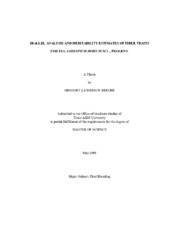| dc.description.abstract | With a demand for high-quality cotton fiber in international markets,
improvement of fiber quality in U.S. grown commercial cultivars is necessary. Smith,
Hague, Thaxton, and Jones developed a group of experimental lines in 2008 that
produced extra-long staple fiber (>35.6 mm). This study determined general combining
ability (GCA), and specific combining ability (SCA) of four experimental ELS lines and
four commercial cultivars utilizing biplot and conventional diallel analysis, determined
performance of F2 progeny, calculated broad-sense (H2) heritability estimates for F2
progeny, and verified the ability of selected parental combinations to produce variable
segregating populations with variability of fiber traits. Initial crosses were made in 2007,
with additional crosses being made in the field and in a greenhouse in 2008. F1 progeny
and parents were grown in a replicated trial near College Station, TX, in 2007 and 2008.
F2 progeny lines and parents were grown in replicated trials at two locations in 2008.
Due to a significant GxY interaction for all F1 fiber traits, data were reported by years.
Experimental ELS lines showed positive GCA effects for fiber length, strength, and length uniformity, while the majority of commercial lines showed negative effects.
These findings suggest experimental ELS lines contain alleles for fiber length and
strength not present in this particular set of commercial cultivars. Experimental ELS
lines exhibited negative GCA effects for lint percent, which suggests further selection is
needed for these lines to be commercially competitive. Performances of F2 lines suggest
differences in fiber traits are predominantly due to additive gene action. Furthermore,
data suggests alleles for fiber length and strength is present in the experimental ELS
lines not present in the commercial cultivars. F2 progeny exhibited moderate heritability
for all fiber traits. Sufficient variability exists within selected F2 progeny to select for
phenotypes exhibiting improved fiber quality over commercial cultivar potential with
similar agronomic qualities of commercial cultivars. The ELS lines are a useful source
of germplasm for plant breeders looking to improve fiber qualities in their programs. | en |


